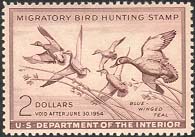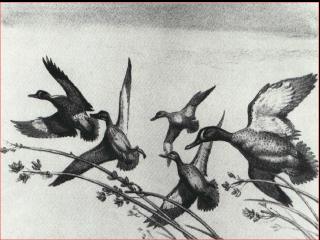

Back to RW20 Back to the Federal Index Home
A LITTLE HISTORY ON THE 20TH (1953-54) DUCK STAMP ARTIST


Clayton B. Seagears was born on August 15, 1901. When he attended the University of Michigan, he majored in zoology and journalism as an undergraduate. After he received his degree, he remained at the University as an instructor in vertebrate zoology and economic conservation under Alexander G. Ruthven. He devoted his next 13 years, from 1924 to 1937, to newspaper work with the Orange Independent Corporation, a newspaper publishing corporation owned by the Harrimans of New York state. During his tenure at the paper, he handled sports, outdoor columns, and general illustrating. It was then that he started using his artistic skills professionally and his syndicated newspaper cartoon feature called "The Inside on the Outdoors" reached its peak of use in 127 papers across the country.
He left the newspaper business and joined the New York State conservation Department as a game research investigator in 1937. Some time later he became director of the Division of Conservation Education. In 1946, he became the founder of The Conservationist magazine, the official publication of the New York State Conservation Department.
From the time he founded The Conservationist, until his retirement from the New York Conservation Department in 1962, he did much of his work for the magazine. Deer and waterfowl were his favorite subjects.
When he designed his Duck Stamp he used as models, a pair of hand-raised Blue-winged Teal. They had been collected at Stony Island, New York, and from Chesapeake Bay near Bishop's Head. To add to the painting he got some pressed stalks of hard stemmed bulrushes for the wind blown decoration. He already had on hand some sketches of Teal. He notes an interesting coincidence about his painting: "The young drake from which the sketches for the stamp were made had been collected the same day in 1934 that he bought the 'Ding' Darling stamp."
During his career as a writer and painter, Mr. Seagears' articles or illustrations appeared in such books or magazines as the Saturday Evening Post, The Hunter's Encyclopedia, The Ruffed Grouse, Colliers, Outdoors Unlimited, Field and Stream, American Gun, as well as in The Conservationist and others.
Mr. Seagears didn't call it quits on his paining career when he retired. After his retirement from active conservation work, he went about the business of fulfilling a lifelong desire: That of painting certain exotic forms of wildlife throughout the world. He traveled extensively making hundreds of sketches and many watercolors in Japan, Ceylon, Thailand, India, the Greek Islands, Surinam, Europe, and a dozen islands in the Caribbean. He took his wife along with him on a painting and photographing safari in east Africa. As in his earlier life, he worked mostly in tempera and specialized in birds with emphasis on waterfowl and upland game.
Mr. Seagears died in March 1983.
-------------------------THE ART-------------------------
Blue-winged Teal was painted in black India ink wash. A stone lithograph was hand
pulled using black ink on white paper. The print was hand signed by the artist in pencil
but not numbered. The image size of the print is 6 3/4" x 9".
-------------------------THE STAMP-------------------------
Blue-winged Teal...Engraved by the Federal Bureau of Engraving from the original artwork.
Printed in maroon ink. The stamp sold for two dollars. Postal records
show 2,268,446 stamps sold. First day of sale was July 1, 1953.
Most of the information contained above is from the book Federal Duck Stamp Story, Fifty Years of Excellence, by Laurence F. Jonson; Alexander & Co. It is used here with permission from the author. For more information on this book, please click here.